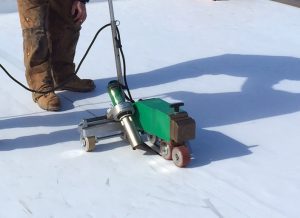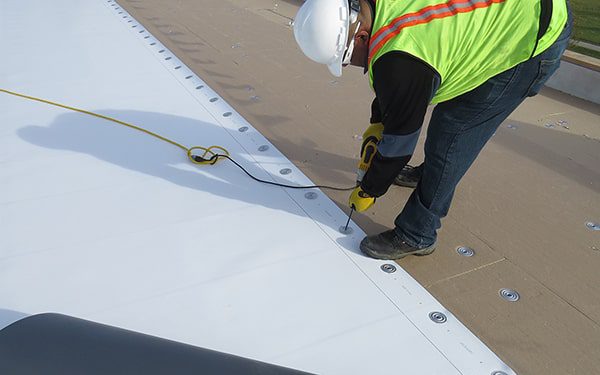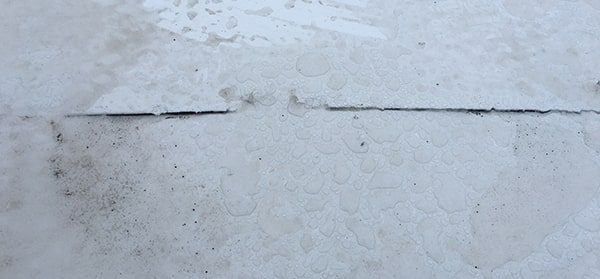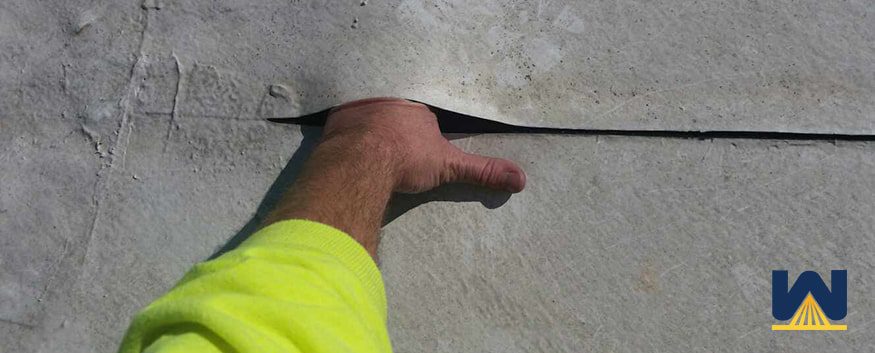So, you have a TPO roof, and water has entered your building.
What are you supposed to do?
Here’s some advice from a roofing contractor that’s been in business for more than 40 years…stop what you’re doing and contact a roofing contractor.
Maybe it’s the contractor you have a warranty with, or maybe it’s a contractor that’s in your area, but you need a professional on your roof immediately.
Why?
Because every time it rains, more and more of your insulation is saturated with water.
And if it gets to a point where more than 25% of your roof’s insulation is saturated, in most cases your best option is to completely tear everything off your roof.
But…if you get to the problem immediately, you might be able to go a less expensive route.
Maybe you can restore your roof (which costs about $4-$8 per sq. ft.) instead of completely ripping everything off and installing a new roof system (which costs at least $6-$12 per sq. ft.)?
Maybe all you need to do is repair a small area, and that’s it?
But you’ll never know unless you get a professional on your roof.
One thing we do know is if the problem is ignored, the problem is only going to get worse…and the solution to get your roof watertight will cost you more money.
In this article, you’ll learn:
- How water comes through on a TPO roof
- What a small repair will look like
- What happens if there’s medium damage on your roof
- And what happens if there’s severe damage on your roof
You’ll also learn what a roofing contractor looks for and how they access water damage on a roof.
Let’s get started.
How does water come through on a TPO roof?
There are many ways in which water can come through a TPO roof. We’ll examine the most common scenarios below.
Water can enter a TPO roof through the seams
On a TPO roof, the roof membrane is made by combining large sheets. These sheets can be chemically-adhered together by overlapping the sheets and then fusing them together through heat.

Over time, this chemical bond can degrade.
Also, there might’ve been issues with the initial installation.
When the seams were heat-welded together, maybe the contractor used too much heat, this would result in a burn which can leave pinholes in the membrane.
Or perhaps the contractor didn’t use enough heat, which upon installation may look like the seams are attached when they aren’t.
When seams separate, there is a clear opportunity for water to enter the insulation below.
Water can enter a TPO roof through the fasteners
On a TPO roof, a sheet will be fastened down to an insulation board using plates and screws before another sheet is heat welded over it.

Source: https://www.pepperconstruction.com/blog/peeling-back-layers-tpo-roofing-systems
Over time, fasteners can begin to back out. When they do, the hole that the screw created has left an opportunity for water to enter the underlying insulation.
Water can enter a TPO roof through the flashings
Flashings are installed on TPO roofs to prevent water from entering the building when the roof meets a vertical structure, such as a wall or HVAC unit.
The common problem TPO roofs have is since the TPO roof comes in sheets, it needs to be custom cut to fit around the penetrations.
Then boots and flashings are glued or welded onto the vertical structure.
This can create an opportunity for water to enter your building if the weld breaks or the glue loses adhesion.
Water can enter a TPO roof through holes, cracks, or punctures
Flying debris, dropped tools, nails, or screws that have been stepped on, all these things can lead to a hole, crack, or puncture on a TPO roof.
With TPO sheets being very thin, it creates an entry point for water to enter the insulation.
Once the water hits the insulation, it can travel horizontally (and downwards) until it reaches the roof deck and then into your building.
This is why it’s important to have a maintenance program on your roof, that way, at least once a year, a roofing contractor can identify these areas and minimize the damage.
If holes are left alone for a lengthy period, it could saturate the insulation to a point where the entire roof will need to be replaced.
NOTE: If a roof’s insulation is less than 25% saturated, in most cases, it can be restored. If there’s more than 25% saturation, in most cases, it’s beneficial to the building owner to remove 100% of the roof. A complete roof removal will cost substantially more than a roof restoration.
What repair options will you have?
This all comes down to the results of a physical inspection, and what the results of core samples and/or infrared inspections display.
Let’s go through three likely scenarios based on the severity of damage to your TPO roof.
Scenario #1 – minimal damage
Say there’s water dripping down into the cafeteria of your building. The roofer goes onto the roof, straight above the cafeteria’s location, and realizes that flashing has been damaged on an exhaust pipe.
The roofer then pulls core samples at 10-foot increments around the pipe to determine how much of the insulation is saturated.
It’s determined that only a 5 ft by 5 ft section of insulation is saturated.
The contractor removes this area and replaces it with like material.
Since the roofer is on the roof, they perform a visual inspection of the rest of the roof and determine that no other flashings are loose. There are no loose seams, and no punctures in the roof. The roof appears to be in good standing order.
Scenario #2 – medium damage
The same scenario as #1, but let’s say that there’s a larger area of the insulation that’s saturated. Let’s say that after pulling core samples, a 50 x 50-foot section is saturated.
Let’s also say that after an inspection of the rest of the roof, multiple holes and cracks are found.
These areas might not have allowed water to enter your building yet, but with every rainfall, more and more of the insulation is collecting water. Someday that water will find a way into the building.
It’s determined that 15% of the roof has saturated insulation.
In this scenario, a likely solution would be to restore the roof with a silicone coating system.
Scenario #3 – severe damage
The same scenario as #2, but there are more cracks and more loose flashings on the TPO roof.
Plus, it’s determined that some of the seams are no longer attached.

Upon seeing this, a roofing contractor will perform an infrared inspection to determine how much of the roof is saturated.
After the infrared inspection, let’s say that 50% of the roof is saturated.
In this scenario, it would be beneficial to the building owner to remove the entire roof and start over.
What are your next steps?
Your next step is to contact a commercial roofing contractor. The reason is that the damage is only getting worse, and the cost to repair is only increasing.
Every time it rains, the more your insulation is getting saturated, which will need to be removed, taken to a landfill, and replaced with similar material.
The less roofing material that you need to replace, the less it’s going to cost you.
Want to learn more about the subjects talked about in this post?


